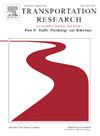Predictors of cyclists’ and pedestrians’ behavior in interactions with turning (Automated) vehicles − Insights from a Wizard-of-Oz study in real traffic
IF 3.5
2区 工程技术
Q1 PSYCHOLOGY, APPLIED
Transportation Research Part F-Traffic Psychology and Behaviour
Pub Date : 2025-02-27
DOI:10.1016/j.trf.2025.02.023
引用次数: 0
Abstract
The subjective and objective safety of interactions between vulnerable road users (VRUs), such as cyclists and pedestrians, and automated vehicles (AVs) is essential for the successful integration of AVs into real-world traffic. Laboratory studies have shown that vehicle dynamics are particularly crucial for the experience and behavior of VRUs when interacting with both AVs and manually-driven vehicles (MVs). However, since AVs are still rare in urban traffic, field study results are also scarce. The present study employs the Wizard-of-Oz (WoOz) method, where a safety driver is hidden inside the vehicle, making it appear driverless from the outside. This vehicle then interacted with naïve VRUs at a signal-controlled intersection in Munich. Unlike in comparable studies, the complex traffic scenario involved crossing in front of turning vehicles. The study analyzed the extent to which the behavior (recorded via video) and experience (post-crossing survey) of the VRUs differed depending on whether the vehicle was seemingly automated or an MV. Additionally, known influencing factors, such as age, gender, and vehicle dynamics, were included in the analysis to determine whether potential effects remained significant. The results indicate that the automation status of the vehicle influenced behavior (crossing time, head movements towards the vehicle, post-crossing reactions). Furthermore, vehicle dynamics were particularly decisive for behavior and also seemed to influence perceived safety. This underscores the importance of considering vehicle dynamics in the development and implementation of AVs.
骑自行车者和行人与转向(自动)车辆互动时的行为预测——来自真实交通中Wizard-of-Oz研究的见解
弱势道路使用者(如骑自行车者和行人)与自动驾驶汽车(AVs)之间互动的主观和客观安全性对于自动驾驶汽车成功融入现实交通至关重要。实验室研究表明,在与自动驾驶汽车和手动驾驶汽车(mv)互动时,车辆动力学对vru的体验和行为尤为重要。然而,由于自动驾驶汽车在城市交通中仍然很少,因此实地研究结果也很少。目前的研究采用了Wizard-of-Oz (WoOz)方法,其中安全驾驶员隐藏在车内,使其从外部看起来无人驾驶。然后,这辆车在慕尼黑的一个信号控制十字路口与naïve vru进行交互。与同类研究不同的是,这个复杂的交通场景涉及到在转弯的车辆前面过马路。该研究分析了vru的行为(通过视频记录)和体验(过马路后的调查)在多大程度上取决于车辆是自动驾驶还是自动驾驶。此外,已知的影响因素,如年龄、性别和车辆动力学,也包括在分析中,以确定潜在的影响是否仍然显著。结果表明,车辆的自动化状态影响行为(过马路时间、头向车辆移动、过马路后反应)。此外,车辆动力学对行为尤其具有决定性,似乎也影响到感知的安全性。这强调了在自动驾驶汽车的开发和实施中考虑车辆动力学的重要性。
本文章由计算机程序翻译,如有差异,请以英文原文为准。
求助全文
约1分钟内获得全文
求助全文
来源期刊
CiteScore
7.60
自引率
14.60%
发文量
239
审稿时长
71 days
期刊介绍:
Transportation Research Part F: Traffic Psychology and Behaviour focuses on the behavioural and psychological aspects of traffic and transport. The aim of the journal is to enhance theory development, improve the quality of empirical studies and to stimulate the application of research findings in practice. TRF provides a focus and a means of communication for the considerable amount of research activities that are now being carried out in this field. The journal provides a forum for transportation researchers, psychologists, ergonomists, engineers and policy-makers with an interest in traffic and transport psychology.

 求助内容:
求助内容: 应助结果提醒方式:
应助结果提醒方式:


